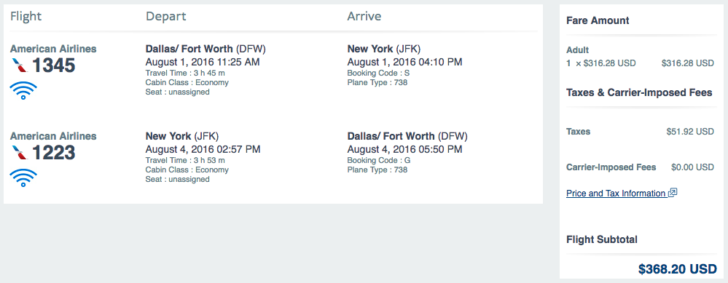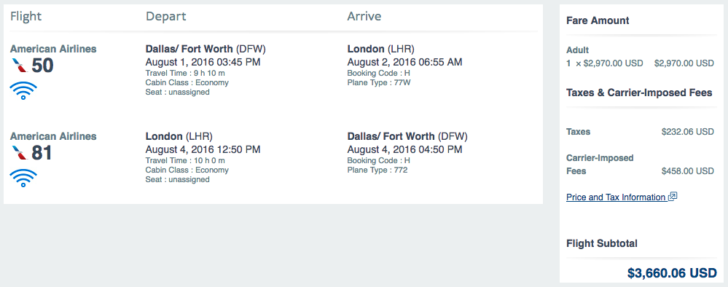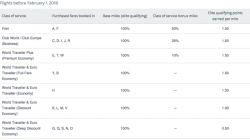One of the best aspects of frequent flyer programs is that you can often earn and redeem miles on partner airlines. As more and more carriers have cut benefits or adjusted their award charts (usually devaluations), it helps that you can maintain your flying patterns but credit to a partner.
Many readers asked me for more information about Alaska Airlines Mileage Plan after American Airlines made its latest devaluation to the AAdvantage program, including shifts to a revenue-based scheme for crediting miles. Alaska still uses distance, which tends to mean more miles for the average traveler.
At the time I suggested that Alaska would inevitably change the way it credits miles for flights operated by American Airlines. However, I also hoped that it would be delayed until September or even later. That would provide a interim period during which people could still fly American and credit to Alaska to earn more miles.
New Chart Effective August 1, 2016
Unfortunately my timing was off. Alaska Airlines announced today that it will also change the rules for earning miles on American Airlines-operated flights as of August 1. These changes will affect all flights departing on or after August 1, even those already booked.
Although the miles awarded will still be based on the distance of a flight, that will be adjusted by a factor somewhere between 25% and 200% according to the booking or fare class (a letter that indicates the rules and priority associated with your ticket). Previously this multiplier ranged from 100% to 150%. (Upgraded flights earn miles according to the original booking class, not the upgraded class.)
| Cabin | Booking Class | Current Miles Awarded | New Miles Awarded |
|---|---|---|---|
| First Class | F | 150% | 200% |
| A, P | 150% | 150% | |
| Business Class | J | 125% | 200% |
| D, I | 125% | 150% | |
| Economy Class | R | 100% | 150% |
| Y, H, K, L, M | 100% | 100% | |
| V, G | 100% | 75% | |
| N, S | 100% | 50% | |
| Q, O | 100% | 25% |
Alaska Airlines already uses a multiplier for its own flights and for flights operated by its partner airlines. The real change here is that typically inexpensive tickets will have a lower multiplier and typically expensive tickets will have a higher multiplier.
I say “typically” because the booking class is no guarantee of price, which also depends on where you’re flying. I’ve seen plenty of tickets with high booking classes that were actually inexpensive due to cheap destinations or even mistake fares. (I’ve also seen the reverse.)
How Many Miles? Some Practical Examples
Even though American Airlines is the third major U.S. carrier to switch to a revenue-based program in recent years, many people still get confused about how this will affect the number of miles they earn for every flight. That’s why I want to provide two examples and also show how, despite Alaska’s changes, it can still be beneficial to some people. These examples exclude any bonuses earned for elite status.
Dallas to New York: Alaska Wins
Flying on American Airlines between Dallas and New York in the first week of August will cost $368.20 and earn 1,585 award miles with American AAdvantage under the new revenue-based rules.
This is an S fare on the outbound and G fare on the return. Under the old Alaska Airlines earning chart, you would earn 1,391 miles (100%) in each direction for a total of 2,782 award miles. However, the new system will only earn 696 miles on the outbound (50%) and 1,043 miles on the return (75%) for a total of 1,793 award miles. You’ll still earn more miles by crediting to Alaska Airlines. The difference is simply less extreme.
Dallas to London: American Wins
Now let’s look at an international flight from Dallas to London traveling on the same dates. This will cost $3,660.06 and earn 17,140 award miles with American AAdvantage.
As an H fare in each direction, it earns 100% of the distance flown when credited to Alaska Airlines. This particular booking class is not affected by the Alaska Mileage Plan changes. However, the itinerary is only 9,500 flown miles and so will earn only 9,500 award miles. You actually earn fewer miles with Alaska Airlines regardless of its change in policy.
It’s Difficult to Predict
The main reason we’re seeing differences here between the miles earned through Alaska’s loyalty program and American’s loyalty program is that the former still looks at distance while the latter looks at price.
A last-minute business traveler could very well pay more than $368 for a ticket to New York and earn more miles with American. It’s just as easy for a leisure traveler to book in advance and pay as little as $1,200 for a flight to London; depending on the booking class he or she could earn more with Alaska.
Ultimately you will need to do more homework to make sure you earn the most miles for every flight. Remember that American does not award miles for government taxes and fees included in the final ticket price.
Will Alaska Offer Fewer Miles on Its Own Flights?
Does today’s news mean that Alaska has plans to make similar changes to how it awards miles for its own flights? Alaska Airlines representatives told me that is definitely not the case.
Flights on Alaska Airlines will continue to earn a minimum of 100% of the distance flown for even the cheapest economy fares and up to 175% of the distance flown if you travel in first class. In fact, you can still earn these higher rates if you book your American Airlines flight as an Alaska Airlines codeshare, meaning it has an AS flight number.
But — and here’s a potential warning for some of you — flights operated by Alaska Airlines and with an American Airlines flight number will earn miles under the new rates for American. That might mean fewer miles. Refer back to the examples above.
(If you book an American Airlines-operated flight marketed by another partner, such as a BA flight number or a CX flight number, you’ll also earn miles under the new chart as if it was an American Airlines-operated and -marketed flight.)
Placing These Changes in Greater Context
Partners try to maintain some balance even as they like to promote their individual strengths. When Delta switched to revenue-based earning, Alaska matched them with a new chart for Delta flights that is very similar to the one soon to be in place for American flights. As I said, there was no reason to believe this wouldn’t happen eventually.
I continue to believe that Alaska Mileage Plan provides greater value than most competing programs. Members have access to three domestic airlines (Alaska, American, and Delta) so that they can earn miles faster, as well as a variety of international partners. Miles are generally more valuable since they include a free stopover. Some awards are available at lower prices. Even award travel on American-operated flights can be cheaper booked through Alaska than when booked with AAdvantage miles.
What you give up is some of the seamlessness of a single large airline or formal alliance. Alaska makes it difficult to book travel on multiple partners and doesn’t have access to the same selection as American AAdvantage. Recognition of elite benefits, and particularly upgrades, is limited (but improving) when you travel on a partner. Infrequent travelers may not notice or care.
Today’s changes don’t imply a pending devaluation to Mileage Plan and how it awards miles for flights on Alaska Airlines. This is only a response to changes announced by American — a response that is unfortunate but expected.
Will Alaska’s unique status as the only U.S. carrier to award miles based on distance continue indefinitely? No one knows. But there are enough differences between how Alaska operates its airline and the competition that I remain optimistic.






